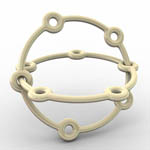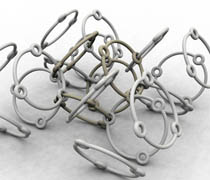



Figure 22a: Connection 1.
Figure 22b: Connection 2.
Figure 23: Final object.
Figure 24: 8 Rings.



Figure 25a: Cuboctahedron and the twisted band.
Figure 25b: Band with holes.
Figure 26: Final object.
4.1. Rings with three Holes. Four rings with three holes each can be used to construct the cuboctahedron structure of Figure 27. But we can also place the four rings on four of the hexagonal faces of the truncated octahedron as in Figure 28.



Figure 27: Cuboctahedron.
Figure 28a: Cuboctahedron.
Figure 28b: Cuboctahedron.



Figure 29: Connecting groups.
Figure 30a: Infinite structure.
Figure 30b: Infinite structure.



Figure 31: Rings with two holes.
Figure 32: Infinite structure.
Figure 33: Rings with four holes.